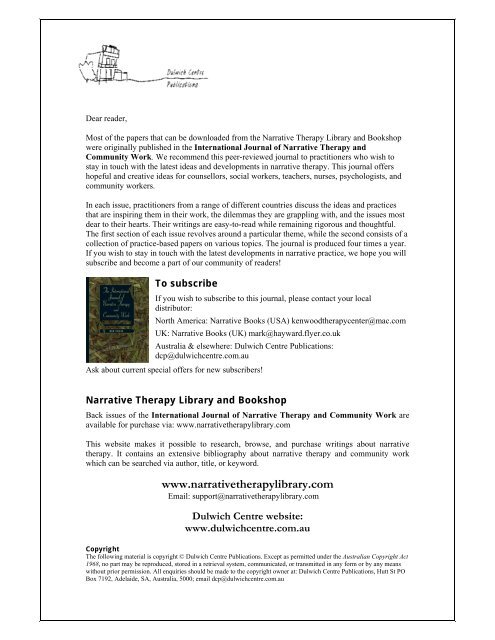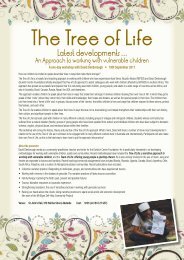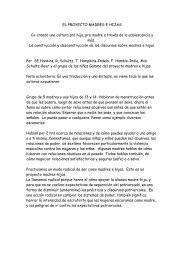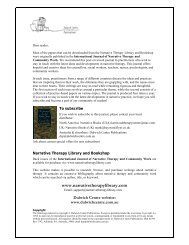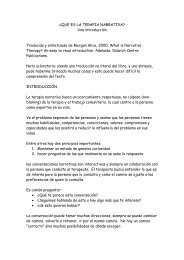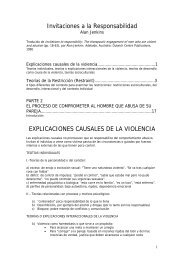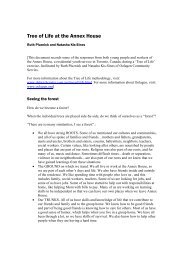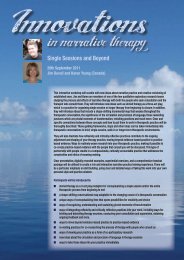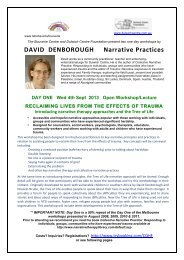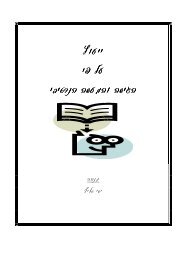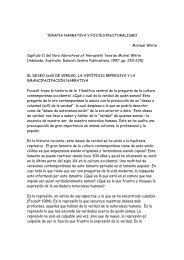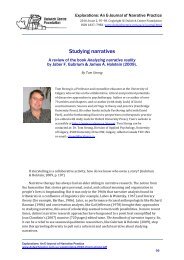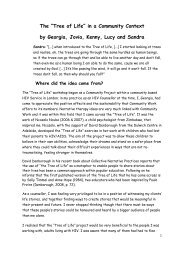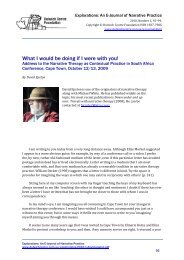Therapist as host: Making my guests feel welcome - Dulwich Centre
Therapist as host: Making my guests feel welcome - Dulwich Centre
Therapist as host: Making my guests feel welcome - Dulwich Centre
Create successful ePaper yourself
Turn your PDF publications into a flip-book with our unique Google optimized e-Paper software.
Dear reader,Most of the papers that can be downloaded from the Narrative Therapy Library and Bookshopwere originally published in the International Journal of Narrative Therapy andCommunity Work. We recommend this peer-reviewed journal to practitioners who wish tostay in touch with the latest ide<strong>as</strong> and developments in narrative therapy. This journal offershopeful and creative ide<strong>as</strong> for counsellors, social workers, teachers, nurses, psychologists, andcommunity workers.In each issue, practitioners from a range of different countries discuss the ide<strong>as</strong> and practicesthat are inspiring them in their work, the dilemm<strong>as</strong> they are grappling with, and the issues mostdear to their hearts. Their writings are e<strong>as</strong>y-to-read while remaining rigorous and thoughtful.The first section of each issue revolves around a particular theme, while the second consists of acollection of practice-b<strong>as</strong>ed papers on various topics. The journal is produced four times a year.If you wish to stay in touch with the latest developments in narrative practice, we hope you willsubscribe and become a part of our community of readers!To subscribeIf you wish to subscribe to this journal, ple<strong>as</strong>e contact your localdistributor:North America: Narrative Books (USA) kenwoodtherapycenter@mac.comUK: Narrative Books (UK) mark@hayward.flyer.co.ukAustralia & elsewhere: <strong>Dulwich</strong> <strong>Centre</strong> Publications:dcp@dulwichcentre.com.auAsk about current special offers for new subscribers!Narrative Therapy Library and BookshopBack issues of the International Journal of Narrative Therapy and Community Work areavailable for purch<strong>as</strong>e via: www.narrativetherapylibrary.comThis website makes it possible to research, browse, and purch<strong>as</strong>e writings about narrativetherapy. It contains an extensive bibliography about narrative therapy and community workwhich can be searched via author, title, or keyword.www.narrativetherapylibrary.comEmail: support@narrativetherapylibrary.com<strong>Dulwich</strong> <strong>Centre</strong> website:www.dulwichcentre.com.auCopyrightThe following material is copyright © <strong>Dulwich</strong> <strong>Centre</strong> Publications. Except <strong>as</strong> permitted under the Australian Copyright Act1968, no part may be reproduced, stored in a retrieval system, communicated, or transmitted in any form or by any meanswithout prior permission. All enquiries should be made to the copyright owner at: <strong>Dulwich</strong> <strong>Centre</strong> Publications, Hutt St POBox 7192, Adelaide, SA, Australia, 5000; email dcp@dulwichcentre.com.au
<strong>Therapist</strong> <strong>as</strong> <strong>host</strong>:<strong>Making</strong> <strong>my</strong> <strong>guests</strong> <strong>feel</strong> <strong>welcome</strong>By Jodi AmanJodi Aman can be reached atThe Center for Narrative Practice,240 E. Ridge Rd., Rochester, NY 14617, USA.(1-585) 544 5342, oremail: jodiaman@yahoo.comThis paper provides an account of how themetaphor of ‘therapist <strong>as</strong> <strong>host</strong>’ can shapetherapeutic practice. It describes a range ofways in which those seeking counselling can be<strong>welcome</strong>d to the experience of therapy.Particular attention is paid to welcomingchildren. Considerations relating to the physicalaesthetics of consulting rooms, marketing,documentation and the use of websites arediscussed.Keywords: therapist <strong>as</strong> <strong>host</strong>, hospitality, <strong>welcome</strong>The International Journal of Narrative Therapy and Community Work2006 No. 3 www.dulwichcentre.com.au3
GREAT GRANDMA FRANCESAbout a month ago, I videotaped <strong>my</strong>grandmother talk about her family when she w<strong>as</strong>young. Grandma Lily is the l<strong>as</strong>t of her siblings andwe wanted these stories to be ever available to usby documenting them in this way. My grandmotherl oves to talk about her rich history of growing upfirst generation Italian in New Yo rk City during theg reat depression. Despite this, I had never beforeh e a rd stories about <strong>my</strong> grandmother’s mother.The stories I heard a month ago moved met remendously! So much so, that I will brieflymention them here .My great-grandmother Frances loved to cookand bake. She raised eight children on herh u s b a n d’s small income <strong>as</strong> a barber and, it seems,fed most of New Yo rk. Grandma Lily spoke ofconstant company being fed at <strong>my</strong> gre a t g r a n d m o t h e r ’s table. Wo rking women, her childre n’sfriends, the down-and-out, meter readers, and thed e l i ver y persons, we re all treated <strong>as</strong> her cherished<strong>guests</strong>. She cared for them, talked and laughed withthem, shared their stories and comforted many ofthem. Bags of chocolate chips <strong>as</strong> big <strong>as</strong> chairs we reo rd e red regularly and, for E<strong>as</strong>ter one ye a r, sheo rd e red a crate of eggs <strong>as</strong> big <strong>as</strong> an ove n !Everything w<strong>as</strong> consumed in the warmth of akitchen filled with love. I can almost smell thecakes and pizza!When the kids we re older and married, most ofthem and their growing families still lived togetherin the same house. They built a store off the fro n tof their home and opened a small grocery andsandwich shop. Lily described to me that, inaddition to the whole family, many other peoplehelped out in the store. People who had trouble intheir lives, we re grieving or otherwise struggling,would be ‘taken in’ by Frances and her family bycoming to work in the store. After several monthsthese helpers would be <strong>feel</strong>ing much better abouttheir lives and would then move on. This left mewondering about Frances. How did being in hercompany affect these people so dr<strong>as</strong>tically?What does hospitality like this provide a person?Did <strong>feel</strong>ing cared for and loved make the diff e re n c ein these people’s lives or w<strong>as</strong> this due to thec o n ver sations that we re shared while theyate together?THERAPIST AS HOSTWe b s t e r ’s Dictionary defines ‘hospitality’ <strong>as</strong> thequality of receiving and treating <strong>guests</strong> orstrangers in a warm, friendly and generous way.For some time now, I have been exploring howpractices of hospitality can influence <strong>my</strong> work <strong>as</strong> atherapist. The metaphor of a therapist being a <strong>host</strong>w<strong>as</strong> introduced to me in a workshop taught byDavid Epston (2003). This fit wholeheartedly withh ow I wanted to be both personally andp ro f e s s i o n a l l y. So, I stepped into the rolem o re purposefully.Treating someone <strong>as</strong> a cherished guesta d d resses the power diff e ren tial undisputablein a therapeutic relationship by elevating thestatus of the person who comes to consult thetherapist. This h<strong>as</strong> been so tangible in <strong>my</strong> workthat people have noticed. Re g a rding <strong>my</strong> office, <strong>as</strong> i x t e e n - ye a r-old girl mentioned: ‘It <strong>feel</strong>s like this isa house and I am a guest’. I <strong>as</strong>ked how this mighth a ve contributed to our conversations together andshe said: ‘It’s not like other experiences in whichthe counsellor is ‘the expert’ and I don’t knowanything and they’re telling me what to do ...I am not degraded like that’. I then <strong>as</strong>ked howthis might affect how she <strong>feel</strong>s about herself.She replied: ‘I <strong>feel</strong> like we’re equal’ . 1In the context of <strong>my</strong> work <strong>as</strong> an independentp r a c t i t i o n e r, I am interested in treating thosethat come to consult me in warm, friendly andg e n e r o u s ways from their first introduction tome (i.e., <strong>my</strong> pamphlet, <strong>my</strong> website or theannouncement on <strong>my</strong> voice mail). But this isnot all, I continue to work to make people <strong>feel</strong><strong>welcome</strong> throughout our work and even beyo n d .This commitment to help people <strong>feel</strong> <strong>welcome</strong>and comfortable guides all of <strong>my</strong> actionsin <strong>my</strong> work.In obvious ways, it h<strong>as</strong> influenced <strong>my</strong>demeanor during phone calls and therapeuticc o n versations. For example, I return phone callsand emails pro m p t l y. As well, I use a lot oft e n t a t i ve questioning, checking in and <strong>as</strong>kingpermission during therapeutic conversations. In therest of this paper I will further discuss l e s s o bv i o u sways, how this commitment h<strong>as</strong> shaped <strong>my</strong>m a rketing materials, the organisation and design of<strong>my</strong> office, and <strong>my</strong> paperwork.4The International Journal of Narrative Therapy and Community Work2006 No. 3 www.dulwichcentre.com.au
MARKETING MATERIALSThe target audience guides how marketingmaterials are written. In <strong>my</strong> c<strong>as</strong>e, I have multipleaudiences. I wanted <strong>my</strong> brochure, business cardsand website to invite interest from families andindividuals who might consult me, <strong>as</strong> well <strong>as</strong> fromreferral sources. It is important to me that thesematerials are aesthetically ple<strong>as</strong>ing – I use artworkthat h<strong>as</strong> been generated by children within therapyconsultations. It’s also important that these materialsare e<strong>as</strong>y to understand, and that they provideanswers to commonly <strong>as</strong>ked questions. It is alsoimportant to me that I am transparent about thenarrative approach that I employ in therapeuticconversations and explain why I am interested in it.I have found that this opens the door to otherquestions that people wonder about in relation toour work. Being transparent is another way ofmaking people <strong>feel</strong> more on a level playing fieldwith me.At times, children are less than enthusi<strong>as</strong>ticabout coming to see a therapist, especially when itis not their idea. To address this, I invite parents toperuse <strong>my</strong> website with their children. In the p<strong>as</strong>t,I have consulted other children about what mighthave been helpful to see or know about me to helpthem <strong>feel</strong> less apprehensive about coming totherapy for the first time. They have told me ‘seeinga picture of you’ and ‘seeing you smile’ would helpthem to know that, ‘you are nice’. Since putting <strong>my</strong>picture on <strong>my</strong> website I have received positivefeedback from similar kids who were apprehensiveabout coming: seeing a photograph of me helpedthem to <strong>feel</strong> more comfortable.In a teaching context with Carolyn Markey(2006), I learned that she sends a letter to all thechildren she meets with prior to the first visit.While this is the loveliest idea, I presently cannotmanage to put <strong>as</strong>ide the extra time this would take.However, I cannot ignore the merits of puttingchildren at e<strong>as</strong>e before they visit. So, with Carolyn’spermission, I have put a children’s <strong>welcome</strong> letter‘Markey-style’ on <strong>my</strong> website for kids to read.Hello!My name is Jodi and I am a counsellor.If you are reading this letter, you, yourparents or someone else that cares about yousuggested that you come and meet with me.I really get excited about meeting people onceI hear about them over the phone. I lovebeing a counsellor because I am introducedto new people all the time!I’d like to tell you a bit about what I do.I meet with young people, parents, sometimesgrandparents and friends and talk with themabout the things going on in their lives.For example, I meet with kids who may beworried about their parents’ separation ordivorce, kids who may <strong>feel</strong> scared about goingto sleep at night, leaving mum or going toschool, kids who get te<strong>as</strong>ed by other kids, or<strong>feel</strong> sad sometimes or get angry sometimesand much more.Kids and parents usually <strong>feel</strong> much betterabout things after we get together. This is thebest part for me!If you have any questions, I would loveto answer them. I can’t wait to see you ina few days!Warmly,JodiThe International Journal of Narrative Therapy and Community Work2006 No. 3 www.dulwichcentre.com.au5
DOCUMENTS FROM CHILDRENIt h<strong>as</strong> also been significant to include on <strong>my</strong>website (www.centerfornarrativepractice.com) picturesand documents that have been created fromtherapeutic consultations with children. This enableschildren who are thinking of coming to therapy toget a sense of the things we may be talking about.I’ve included some examples of these documentsand pictures here:6The International Journal of Narrative Therapy and Community Work2006 No. 3 www.dulwichcentre.com.au
The International Journal of Narrative Therapy and Community Work2006 No. 3 www.dulwichcentre.com.au7
OFFICEOver time, <strong>my</strong> belief grows stronger that a safeand cozy space does wonders in making a personcomfortable. The responses people have maderegarding <strong>my</strong> office have strengthened this belief.I have heard: ‘I <strong>feel</strong> so peaceful here’, ‘This roommakes me <strong>feel</strong> relaxed’. I wonder, does physicalcomfort and a <strong>feel</strong>ing of serenity affect thetherapeutic process? I have read about sacredgeometry, and how the sheer architecture of certainancient buildings can calm the mind (Artress 1995).Perhaps a calm space supports a person in gettingdistance from the immediacy of their experience,therefore enhancing the effectiveness of theconversations.Regardless of whether or not it is therapeuticallyenhancing, <strong>my</strong> visitors seem to enjoy the decisionsI have made about <strong>my</strong> office. It is in a centrallocation that is e<strong>as</strong>y to find. It is accessible to thosewith disabilities, in front of a bus stop, with parkingjust outside a direct first floor entrance. The décor issimple but cheery and interesting without beingdistracting. It is all second-hand, which supports <strong>my</strong>environmental values. The seats are comfortable andthere are extra pillows and blankets so people whoneed comfort or suffer from pain can makeadjustments that suit them. My many oxygen givingplants make up for <strong>my</strong> one regret – very fewwindows, none of which open.I have almost no knickknacks on the table andfloor surfaces to avoid pare n t s’ worries that theirchild might be touching something that they are notsupposed to. I learned this from other spaces whereI worked when I had to use rooms that we resomeone else’s and their things we re eve r y w h e re .Now I have a coffee table with only a box oftissues, a tray of magnet toys and two mugs ofcolourful markers. Under the magnet tray I hidedrawing paper. Kids get to <strong>feel</strong> special that they arein on a secret when I disclose <strong>my</strong> very ‘s e c ret st<strong>as</strong>h’!I chose to have a couch in <strong>my</strong> office after someexperimenting. Kids often choose to sit close totheir parents, half on their lap, cuddling betwe e nthem and/or holding their hands. Some of this isnot physically possible in individual chairs.Si g n i f i c a n t l y, when children demonstrate skills andk n owledge about ‘cuddling for comfort’, we canbuild upon this in our therapeutic conve r s a t i o n s(see for example the document on p.6: ‘Ways toGet Used to Your Pa rents Getting Di vo rc e d’ ) .When people come for their appointmentsI greet them at the door and offer water, tea orcoffee. Also, in <strong>my</strong> waiting room, I am particularabout the reading material I display. There are nopublications that in any way support normativefamilies or negative forms of judgement. VegetarianTimes, Daughters, and Zoobooks make the cutat present.PAPERWORKBefore I discuss <strong>my</strong> paperwork, I want toacknowledge the privilege of <strong>my</strong> being inindependent practice. I know this is a privilegebecause I have previously worked at agencies wherea certain approach to counselling w<strong>as</strong> required <strong>as</strong>well <strong>as</strong> certain paperwork, including a full<strong>as</strong>sessment and diagnosis. Being on <strong>my</strong> own affordsme much freedom to practice in accord with <strong>my</strong>post-structuralist philosophy. However, I still havesome requirements <strong>as</strong> I take third-party payment(medical insurance). Though certain required t<strong>as</strong>ksconflict with <strong>my</strong> values, I am going to discuss <strong>my</strong>journey in how I have come to satisfy these withoutsacrificing <strong>my</strong> integrity.When making the decision to accept insurance,I weighed the unwanted requirements with theopportunity to be available to people who could notpay for <strong>my</strong> consultation out of pocket. Acceptinginsurance allows many people to consult me at littleor no cost. This inspired me to develop a way tocomply with insurance companies while minimisingthe effect on a person’s identity conclusions. This isa work in progress however, <strong>as</strong> I am alwayschanging <strong>my</strong> paperwork in response to people’sfeedback, requests and questions <strong>as</strong> well <strong>as</strong> <strong>my</strong> ownnew ide<strong>as</strong>.The <strong>welcome</strong> letter is <strong>my</strong> most significant workin progress. The intention is to give peopleinformation on the first day we meet. Included in theletter is the standard privacy (confidentiality),emergency contact and payment information.However, I have recently added paragraphs thatI hope will serve to decre<strong>as</strong>e the power differencebetween <strong>my</strong>self and the people who consult me.One of these new paragraphs includes adescription of the purposes I have for recording <strong>my</strong>work. I hope this transparency helps people know8The International Journal of Narrative Therapy and Community Work2006 No. 3 www.dulwichcentre.com.au
I love and care about what I do and how I amhelping; and therefore consider them and their livesvery important:I am currently participating in a year longNarrative Therapy Diploma program (untilMarch 2007). As a means of developing ourskills, the faculty requires that we record andreview our therapeutic conversationsregularly. This means I may record (audio orvideo) some of our sessions and listen/watchthem <strong>my</strong>self to critique <strong>my</strong> own work.Recorded sessions are not a requisite to usworking together. You may decline consent.Tapes are stored in a locked cabinet to whichonly I have access. They are recordedover once reviewed.The next new paragraph is about replicatingpeople’s stories outside the context of the therapyroom. Though this does not break any privacy laws,and consulting a supervisor is deemed professional,I often wonder if the general public knows this.I even supply names of the therapists I meet withfor ‘peer supervision’ in c<strong>as</strong>e anyone knows themand this may affect their decision in grantingpermission:Though I am bound by the ethics ofconfidentiality, it may be helpful for thefollowing professional re<strong>as</strong>ons to sharestories of people that I work with: in peersupervision (with Eileen Hurley, MichaelBoucher, Ted Aman and Gene McCabe, JohnKarl), in teaching contexts (<strong>my</strong>self trainingother counsellors), and in the writing<strong>as</strong>signments of the Narrative DiplomaProgram noted earlier. I never use names orother identifying information, so this does notconflict with privacy laws. However, ethics ofcollaboration guide me to still requestconsent. For example, your story is yours andnot mine to represent unless I have yourpermission.I committed to a further addition to the <strong>welcome</strong>letter after reading and reflecting on Sue Mann’s(2000) article Collaborative Representation: Narrativeide<strong>as</strong> in practice. I realised that the only bit ofpaperwork I had not previously been transparentabout w<strong>as</strong> the insurance claim form that I amobligated to fill out and send to the insuranceagency. Within these forms is a section for‘diagnosis’ and I realised that filling this out on <strong>my</strong>own did not sit right. When I made a commitment tobe transparent about how I fill out this section ofthe insurance claim form, I decided to add a furtherparagraph to <strong>my</strong> <strong>welcome</strong> letter. This is what Iadded:If I am billing your medical insurance for ourmeetings, ple<strong>as</strong>e note that I am required tobill under a diagnosis code. The mostcommon codes I use are adjustment disorderwith depressed mood or with anxiety. Iunderstand that circumstances in our lives arealways changing and we are alwaysadjusting. Yet, ‘disorder’ would not be a wordthat I would use if not required. Other thanthis mention, I usually complete this billingform outside of our therapeutic meetings.Ple<strong>as</strong>e <strong>feel</strong> free to <strong>as</strong>k me any questionsabout this or let me know if you want toparticipate more fully in completing the billingform.All other paperwork is written in collaboration.Notes (that I have <strong>as</strong>ked permission to write) anddocuments that are created during meetings areoften copied and taken home by the familiesconsulting me. Letters to other agencies ordocuments needed for other services are writtentogether during our meeting. Letters to doctors arewritten <strong>as</strong> therapeutic letters to the personconsulting me with doctors copied in.There is one final piece of paperwork thatI will mention here. I have recently created aquestionnaire to <strong>as</strong>sist me to take care withhow to relate to those who have consulted me incounselling if I meet up with them in public settings.It is completely optional whether people fill out thisquestionnaire and return it to me:The idea for the following questionnaire cameout of an <strong>as</strong>signment within <strong>my</strong> trainingprogram. I began to worry about how I oughtto relate to you when we bump into eachother out and about. My concerns involvemaking sure people <strong>feel</strong> <strong>my</strong> caring andthoughtfulness, while at the same timeprotecting their privacy. I want to beconsiderate, but am worried that I haven’tThe International Journal of Narrative Therapy and Community Work2006 No. 3 www.dulwichcentre.com.au9
thought of all possible considerations. I aminterested to learn what you think and willappreciate any ide<strong>as</strong> you have. Theinformation I gather will guide me in <strong>my</strong> workwith families and individuals for years tocome.1. What would you like me to be mindful ofwhen I meet you outside <strong>my</strong> office?2. Do you want me to acknowledge you? If yes, in what ways would you prefer that I acknowledge you? 3. Would you like to be introduced to friends and family if they are with me?How shall I introduce you?4. Try to imagine that we meet in a grocerystore or park after we haven’t met insession in <strong>my</strong> office for a long time, what– if anything – different would you wantme to be thinking about?SUMMARYNOTES1Of course, even with significant practices of hospitality,there will always remain a power differential intherapeutic relationships. I have found Michael White’schapter on ‘Therapeutic relationship’ in Narratives of<strong>Therapist</strong>s’ Lives very helpful in relation to this. In thischapter, White discusses a ‘two way account of therapy’that intends to ‘undermine the rigidity of the powerrelation of the therapeutic context’ (White 1997).REFERENCESArtress, L. 1995: Walking a Sacred Path. New York:Roverhead Books.Epston, D. 2003: Workshop Notes, Toronto, May.Mann, S. 2000: ‘Collaborative representation: Narrativeide<strong>as</strong> in practice.’ In Gecko: a journal ofdeconstruction and narrative ide<strong>as</strong> in therapeuticpractice, 2:39-49.Markey, C. 2006: Workshop within International TrainingProgram in Narrative Therapy, <strong>Dulwich</strong> <strong>Centre</strong>,Adelaide, February.White, M. 1997: Narratives of <strong>Therapist</strong>s’ Lives. Adelaide:<strong>Dulwich</strong> <strong>Centre</strong> Publications.In this article, I have attempted to share <strong>my</strong>historic and current hopes of being a hospitabletherapist. I have talked about how <strong>my</strong> <strong>guests</strong>’comfort guides <strong>my</strong> marketing materials, <strong>my</strong> officeand <strong>my</strong> paperwork. I am constantly learning andacting according to these learnings to incre<strong>as</strong>epeople’s comfort. This process is an enjoyable onefor me, <strong>as</strong> I realise that, while I am not making pizzain the Bronx, I am not so far removed from <strong>my</strong> GreatGrandma Frances. In fact, she is more present to methan ever!10The International Journal of Narrative Therapy and Community Work2006 No. 3 www.dulwichcentre.com.au


